Flexible and Highly Sensitive Hydrogen Sensor Based on Organic Nanofibers Decorated by Pd Nanoparticles
Abstract
1. Introduction
2. Experimental
2.1. Depositation of Pd NPs
2.2. Fabrication of the Sensor
2.3. Hydrogen Sensing Measurement
3. Results and Discussion
4. Conclusions
Author Contributions
Funding
Conflicts of Interest
References
- Jacobson, M.Z.; Colella, W.G.; Golden, D.M. Cleaning the air and improving health with hydrogen fuel-cell vehicles. Science 2005, 308, 1901–1905. [Google Scholar] [CrossRef] [PubMed]
- Schlapbach, L.; Züttel, A. Hydrogen-storage materials for mobile applications. Nature 2001, 414, 353–358. [Google Scholar] [CrossRef]
- Zeng, X.-Q.; Wang, Y.L.; Deng, H.; Latimer, M.L.; Xiao, Z.-L.; Pearson, J.; Xu, T.; Wang, H.-H.; Welp, U.; Crabtree, G.W.; et al. Networks of ultrasmall Pd/Cr nanowires as high performance hydrogen sensors. ACS Nano 2011, 5, 7443–7452. [Google Scholar] [CrossRef]
- Kaniyoor, A.; Jafri, R.I.; Arockiadoss, T.; Ramaprabhu, S. Nanostructured Pt decorated graphene and multi walled carbon nanotube based room temperature hydrogen gas sensor. Nanoscale 2009, 1, 382–386. [Google Scholar] [CrossRef]
- Korotcenkov, G.; Han, S.D.; Stetter, J.R. Review of electrochemical hydrogen sensors. Chem. Rev. 2009, 109, 1402–1433. [Google Scholar] [CrossRef]
- Krall, J.; Glocer, A.; Fok, M.-C.; Nossal, S.M.; Huba, J.D. The unknown hydrogen exosphere: Space weather implications. Space Weather 2018, 16, 205–215. [Google Scholar] [CrossRef]
- Minchin, R.F.; Disney, M.J.; Parker, Q.A.; Boyce, P.J.; Blok, W.J.G.D.; Banks, G.D.; Ekers, R.D.; Freeman, K.C.; Garcia, D.A.; Gibson, B.K.; et al. The cosmological significance of low surface brightness galaxies found in a deep blind neutral hydrogen survey. Mon. Not. R. Astron. Soc. 2010, 355, 1303–1314. [Google Scholar] [CrossRef]
- Hübert, T.; Boon-Brett, L.; Black, G.; Banach, U. Hydrogen sensors—A review. Sens. Actuators B Chem. 2011, 157, 329–352. [Google Scholar] [CrossRef]
- Moon, J.; Hedman, H.-P.; Kemell, M.; Tuominen, A.; Punkkinen, R. Hydrogen sensor of Pd-decorated tubular TiO2 layer prepared by anodization with patterned electrodes on SiO2/Si substrate. Sens. Actuators B Chem. 2016, 222, 190–197. [Google Scholar] [CrossRef]
- Anand, K.; Singh, O.; Singh, M.P.; Kaur, J.; Singh, R.C. Hydrogen sensor based on graphene/ZnO nanocomposite. Sens. Actuators B Chem. 2014, 195, 409–415. [Google Scholar] [CrossRef]
- Kotarski, M.; Smulko, J. Noise measurement set-ups for fluctuations-enhanced gas sensing. Metrol. Meas. Syst. 2009, 16, 457–464. [Google Scholar]
- Lee, E.; Lee, J.-M.; Lee, E.; Noh, J.-S.; Joe, J.H.; Jung, B.; Lee, W. Hydrogen gas sensing performance of Pd–Ni alloy thin films. Thin Solid Films 2010, 519, 880–884. [Google Scholar] [CrossRef]
- Öztürk, S.; Kılınç, N. Pd thin films on flexible substrate for hydrogen sensor. J. Alloys Compd. 2016, 674, 179–184. [Google Scholar] [CrossRef]
- Jiang, H.-C.; Huang, M.; Yu, Y.-B.; Tian, X.-Y.; Zhao, X.-H.; Zhang, W.-L.; Zhang, J.-F.; Huang, Y.-F.; Yu, K. Integrated Temperature and Hydrogen Sensors with MEMS Technology. Sensors 2018, 18, 94. [Google Scholar] [CrossRef]
- Varghese, O.K.; Gong, D.-W.; Paulose, M.; Ong, K.G.; Dickey, E.C.; Grimes, C.A. Extreme Changes in the Electrical Resistance of Titania Nanotubes with Hydrogen Exposure. Adv. Mater. 2003, 15, 624–627. [Google Scholar] [CrossRef]
- Johnson, J.L.; Behnam, A.; Pearton, S.J.; Ural, A. Hydrogen Sensing Using Pd-Functionalized Multi-Layer Graphene Nanoribbon Networks. Adv. Mater. 2010, 22, 4877–4880. [Google Scholar] [CrossRef]
- Zilli, D.; Bonelli, P.R.; Cukierman, A.L. Room temperature hydrogen gas sensor nanocomposite based on Pd-decorated multi-walled carbon nanotubes thin films. Sens. Actuators B Chem. 2011, 157, 169–176. [Google Scholar] [CrossRef]
- Kumar, A.; Kumar, A.; Chandra, R. Fabrication of porous silicon filled Pd/SiC nanocauliflower thin films for high performance H2 gas sensor. Sens. Actuators B Chem. 2018, 264, 10–19. [Google Scholar] [CrossRef]
- D’Amico, A.; Natale, C.D. A contribution on some basic definitions of sensors properties. IEEE Sens. J. 2001, 1, 183–190. [Google Scholar] [CrossRef]
- Sun, Y.-G.; Wang, H.H.; Xia, M.-G. Single-walled carbon nanotubes modified with Pd nanoparticles: Unique building blocks for high-performance, flexible hydrogen sensors. J. Phys. Chem. C 2008, 112, 1250–1259. [Google Scholar] [CrossRef]
- Favier, F.; Walter, E.C.; Zach, M.P.; Benter, T.; Penner, R.M. Hydrogen sensors and switches from electrodeposited palladium mesowire arrays. Science 2001, 293, 2227–2231. [Google Scholar] [CrossRef]
- Peng, Y.-T.; Ye, J.-X.; Zheng, L.-L.; Zou, K. The hydrogen sensing properties of Pt–Pd/reduced graphene oxide based sensor under different operating conditions. RSC Adv. 2016, 6, 24880–24888. [Google Scholar] [CrossRef]
- Ou, Y.-J.; Si, W.-W.; Yu, G.; Tang, L.-L.; Zhang, J.; Dong, Q.-Z. Nanostructures of Pd–Ni alloy deposited on carbon fibers for sensing hydrogen. J. Alloys Compd. 2013, 569, 130–135. [Google Scholar] [CrossRef]
- Sieverts, A.; Metallkd, Z. The absorption of gases by metals. Zeitschrift für Metallkunde 1929, 21, 37–46. [Google Scholar]
- Chen, X.-J.; Yasin, F.M.; Eggers, P.K.; Boulos, R.A.; Duan, X.-F.; Lamb, R.N.; Iyer, S.K.; Raston, C.L. Non-covalently modified graphene supported ultrafine nanoparticles of palladium for hydrogen gas sensing. RSC Adv. 2013, 3, 3213–3217. [Google Scholar] [CrossRef]
- Cherevko, S.; Kulyk, N.; Jie, F.; Chung, C.-H. Hydrogen sensing performance of electrodeposited conoidal palladium nanowire and nanotube arrays. Sens. Actuators B Chem. 2009, 136, 388–391. [Google Scholar] [CrossRef]


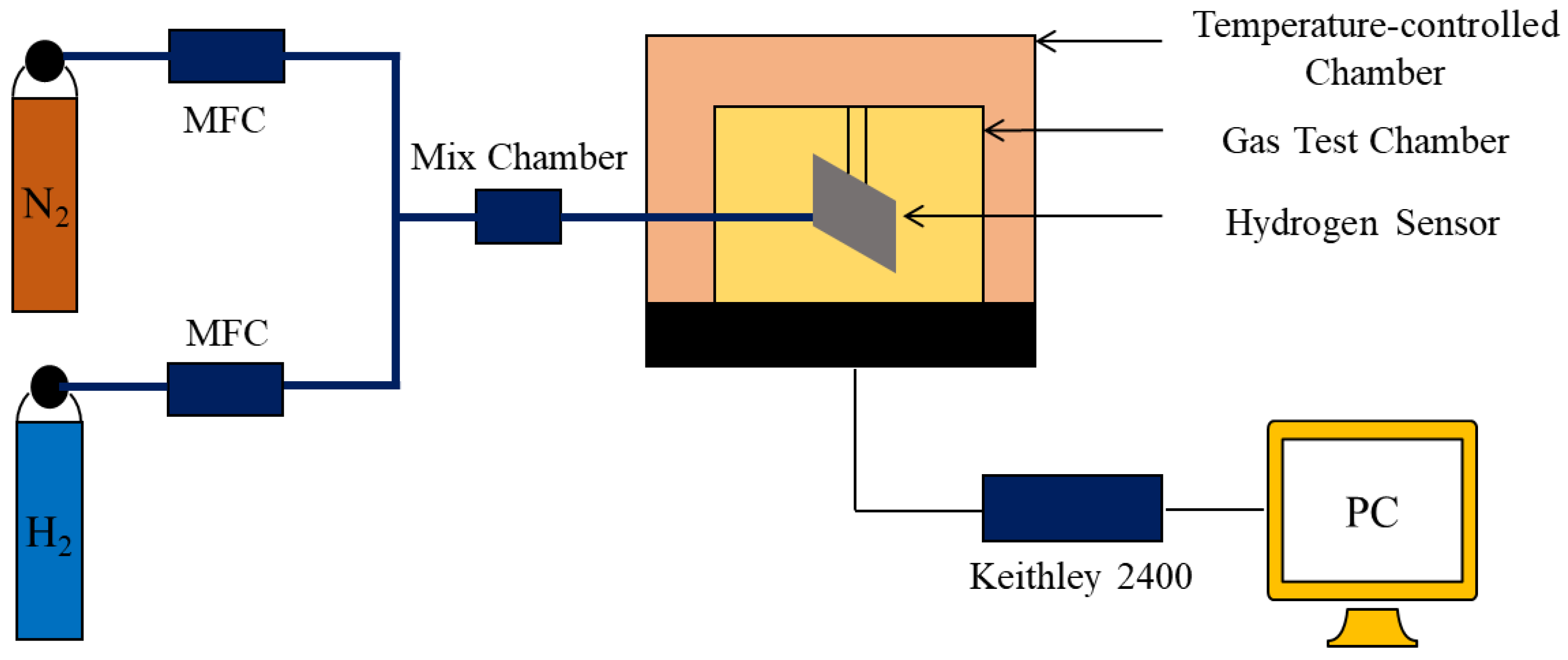

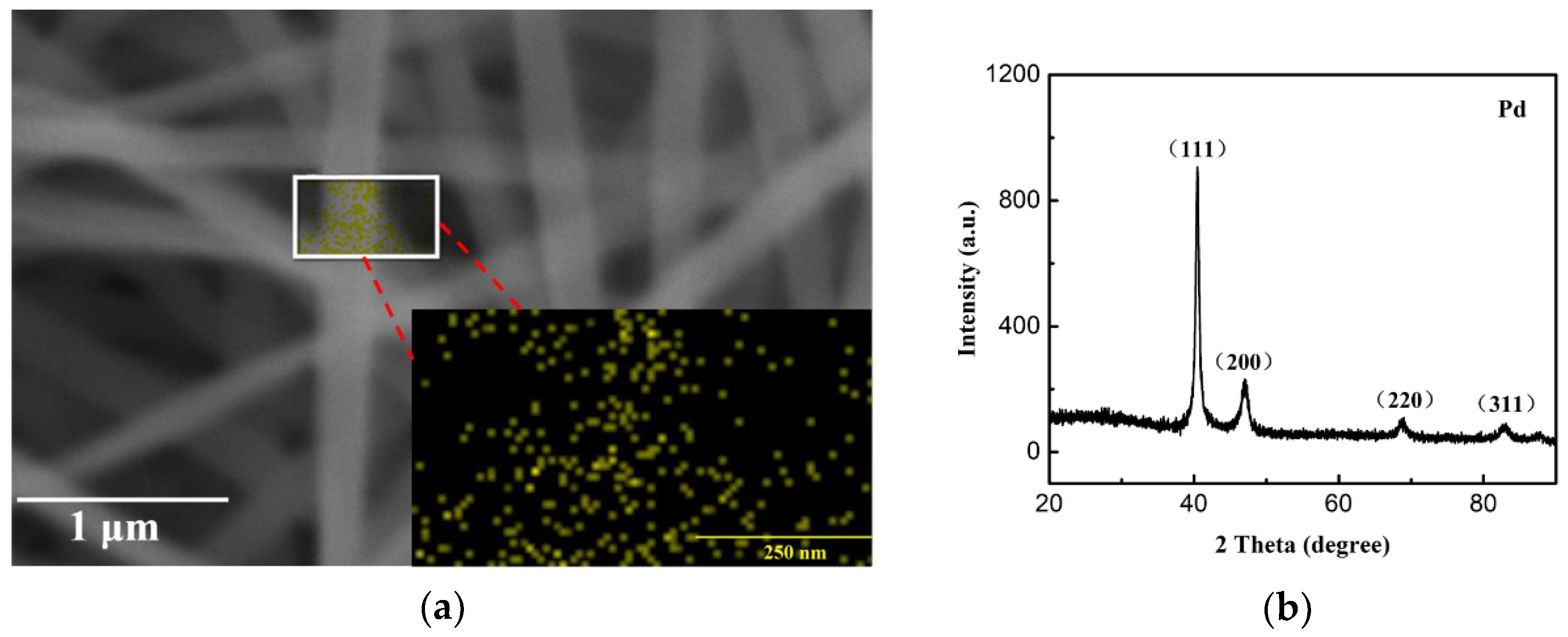
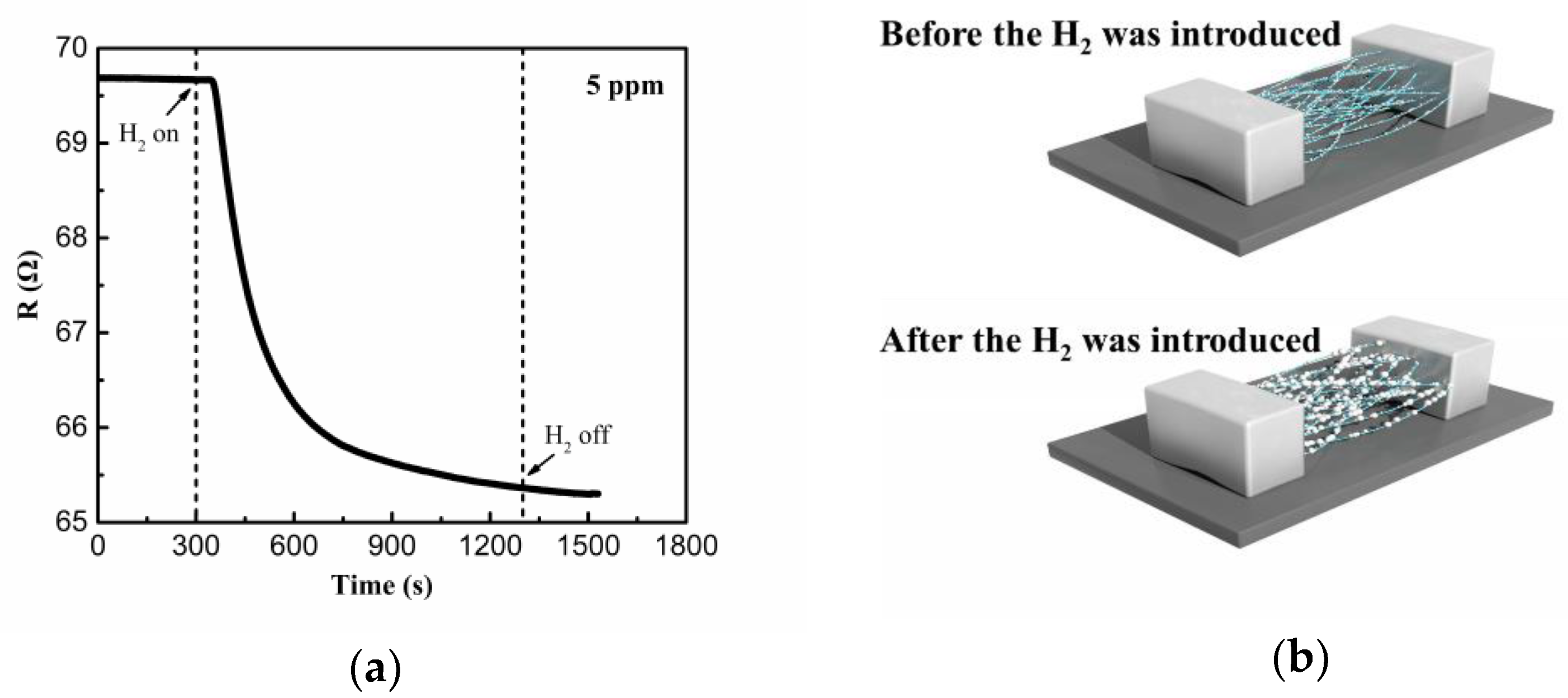
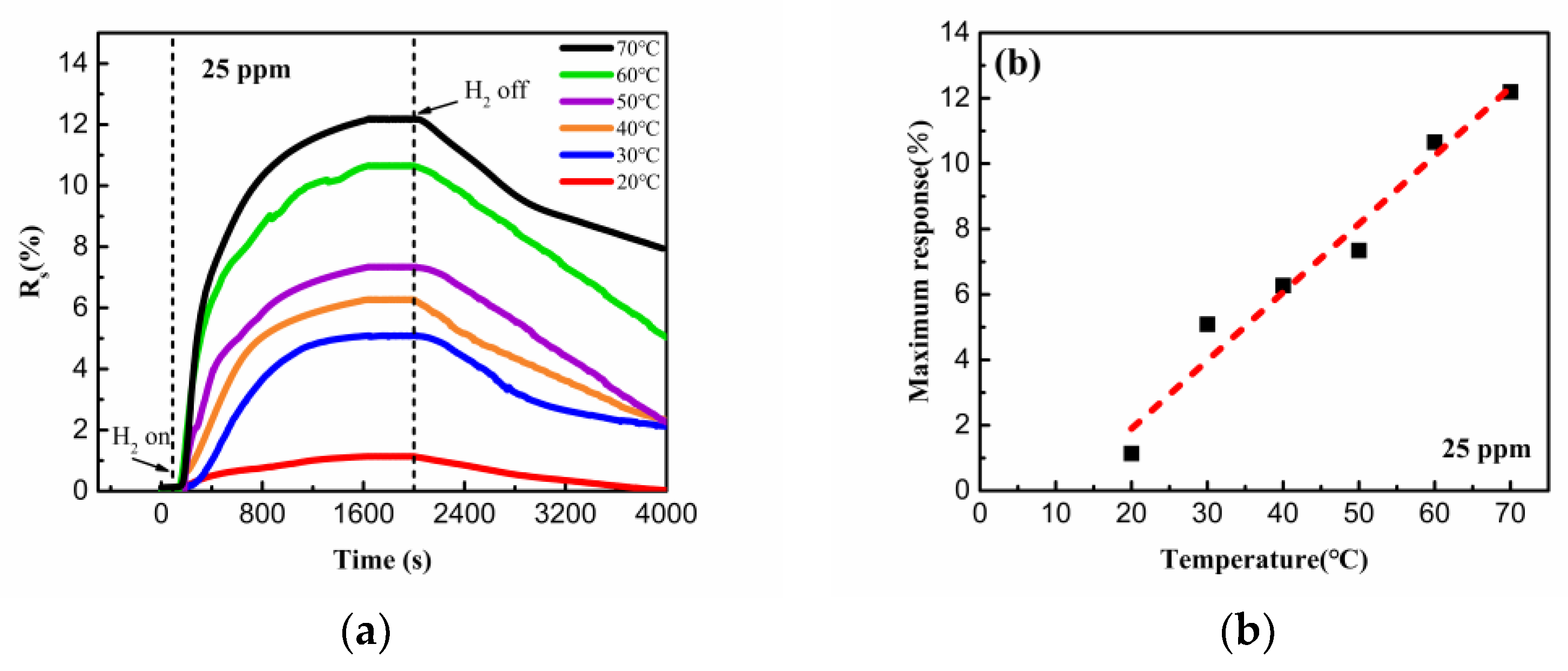
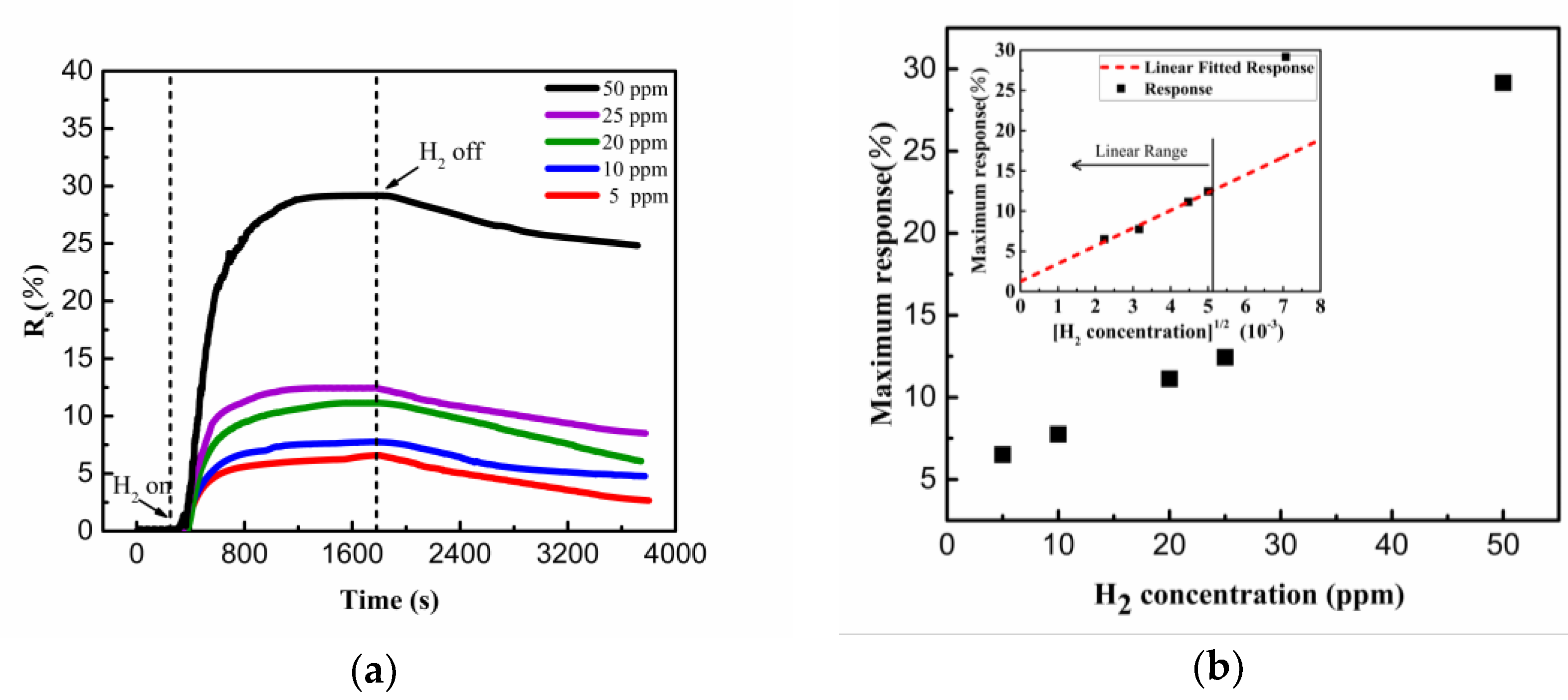

© 2019 by the authors. Licensee MDPI, Basel, Switzerland. This article is an open access article distributed under the terms and conditions of the Creative Commons Attribution (CC BY) license (http://creativecommons.org/licenses/by/4.0/).
Share and Cite
Jiang, H.; Yu, Y.; Zhang, L.; Zhu, J.; Zhao, X.; Zhang, W. Flexible and Highly Sensitive Hydrogen Sensor Based on Organic Nanofibers Decorated by Pd Nanoparticles. Sensors 2019, 19, 1290. https://doi.org/10.3390/s19061290
Jiang H, Yu Y, Zhang L, Zhu J, Zhao X, Zhang W. Flexible and Highly Sensitive Hydrogen Sensor Based on Organic Nanofibers Decorated by Pd Nanoparticles. Sensors. 2019; 19(6):1290. https://doi.org/10.3390/s19061290
Chicago/Turabian StyleJiang, Hongchuan, Yibing Yu, Luying Zhang, Jun Zhu, Xiaohui Zhao, and Wanli Zhang. 2019. "Flexible and Highly Sensitive Hydrogen Sensor Based on Organic Nanofibers Decorated by Pd Nanoparticles" Sensors 19, no. 6: 1290. https://doi.org/10.3390/s19061290
APA StyleJiang, H., Yu, Y., Zhang, L., Zhu, J., Zhao, X., & Zhang, W. (2019). Flexible and Highly Sensitive Hydrogen Sensor Based on Organic Nanofibers Decorated by Pd Nanoparticles. Sensors, 19(6), 1290. https://doi.org/10.3390/s19061290




